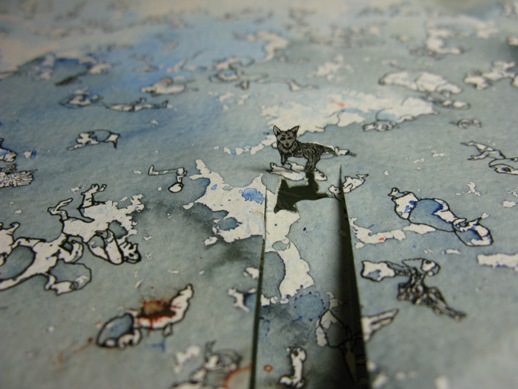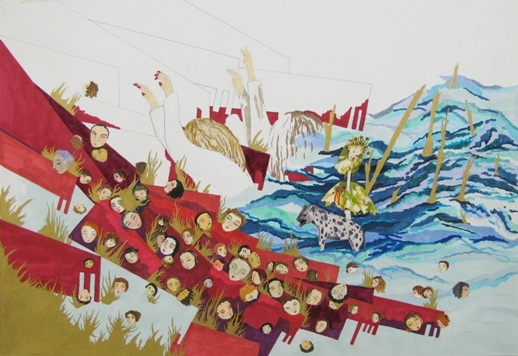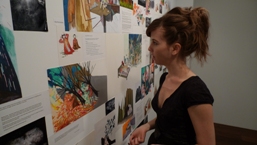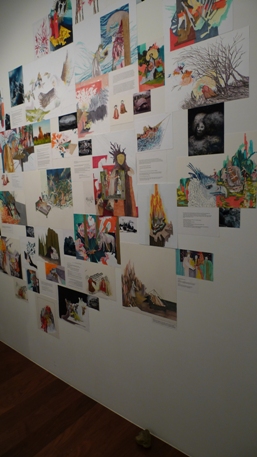Mythical Paper
Arts Initiative Tokyo recently staged an exhibition with two of their artists-in-residence, supported by the Backers Foundation. The title and theme was “Paper Plays”, featuring unusual paper works.
Indian-born Minam Apang has studied in Illinois and Leeds, as well as living in New York, before settling in Bangalore. She is known for her experimentation with automatic drawing and spontaneous blotting work. Argentine Florencia Rodriguez Giles has exhibited in her home country and Brazil, and creates collages works as well as hypnotic photographs of ghost-like figures.
TABlog went along to the recent artist talk they gave for the exhibition and spoke to the pair.
Minam, you’ve travelled, studied and lived in a lot of different cultures. How have you found Tokyo during your three month residency?
Minam: Tokyo is overwhelming. Sometimes it is too much, I don’t like to go to Shibuya! We are always fascinated by Japan in India, Miyazaki’s anime and all that. I always wanted to come here.
You mention anime there. Has there been any direct Japanese influence on your past work or the work for this current exhibition?
Minam: I was not researching like that. I don’t want to make something structured. I don’t like to do too much research. I just want to observe.

Your tribe has no written language and many of its myths and historical stories were not collected until recent anthropological work. In your pieces you have transcribed this heritage very minutely on the paper.

But you’ve written over and over on it, so that in the end you cannot read the words.
Minam: It’s not accessible, you cannot read it. It’s a continuous process, I’m not always thinking exactly what it is.
This is about an absence of words, the inability of written language to express culture. You have previously worked spontaneously a lot, with automatic drawing. Is there a conflict between trying to be spontaneous and free, but also trying to express a complicated cultural message?
Minam: You’re always questioning when you’re making something, who you are, what you’re doing. So I went back to these stories and made these deliberate connections. My work now is not as spontaneous.
The scale for your early work was very big, including scrolls several feet tall. But your current work here is small, presented on low tables.
Minam: This is because of the space I was working in. [The large works] were displayed on the floor. [In Japan] I was given a studio but there are no windows. So I work in my apartment. But I don’t have a desk, it’s very small. It’s a result from where I work. It’s organic that way.
Can you tell us about the use of the threads between the folded paper in the works? And what about the folded paper structure?
Minam: The threads are like the telephone wires I saw in Tokyo, which I think are really, really beautiful. Many people think the telephone wires are ugly but that is what [Japan] is doing, it is happening organically. In the tea ceremony there are many bowls in different shapes. It is asymmetrical. The folds are like mountains. I was thinking of the hanging bridges from my home region. Also there were many bridges in Mumbai but they are no longer there. They are very old bridges.

Your work is very sincere and has a strong message. But the exhibition is called “Paper Play”.
Minam: The title is because both Florencia and I worked with paper, our works refer either directly or obliquely to theater and display a playful experiementation with paper as well. I need my practice to be something playful and enjoyable. The beauty of drawing is that each mark you make is an unpredictable moment, full of promise where the line may take you.

Florencia: I took some Butoh classes in Yokohama with [Yoshito] Ohno. I saw some traditional theatre. I was especially fascinated in Noh because there is some relationship between the sacred and art and also because I’m interested in non-realistic theatre.
Yes, your work often plays with this dichotomy between realism and fiction. Your earlier work contains photographs of strange ghost-like figures which look like Butoh dancers. The material – photography – and the tone is quite different from the work displayed in this exhibition.
Florencia: I have always used drawing to think my works, even for this project of photography, but I’ve never exhibited them. This time I decided to show them in order to bring people closer to the process of a fictional work. The drawings and writings are ideas, thoughts, sensations that appeared during these three months in Tokyo. About the tone, I used to think each project as an organism that has their specific needs.

Florencia: I am not interested in ghosts! I am interested in mythology and fiction. They appear ‘as’ phantoms, as characters that are condemned to act the same script over and over again.
It is theatre again.
Florencia: Yes.
The work here is a wall collage of photographs, drawings, text and even a rock. It is very wide and spread out.
Florencia: When I came here I felt very schizophrenic in a way and I tried to work as I felt. The Japanese syncretic and pragmatic ability to nurture from other cultures as their own – and the free way in which they mix anything as they wish – was a big inspiration in order to make the decision to combine for the first time drawings, digital images, photographs and writings.
This is an interesting partnership. Although your work looks very different, there are similar themes. Minam writes her country’s old myths on her work. And you are interested in fictional mythology.
Florencia: Yes, but in a way it’s completely different. For Minam the mythology is part of her history, for me it’s only fiction. I have no religious or mythological background and maybe that is why I’m so interested in finding one.
Florencia and Minam, thank you for speaking with us.
William Andrews
William Andrews



